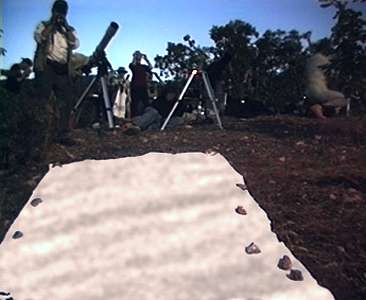Shadow bands

Shadow bands are thin, wavy lines of alternating light and dark that can be seen moving and undulating in parallel on plain-coloured surfaces immediately before and after a total solar eclipse.[1] They are caused by the solar crescent thinning to a narrow slit, which increasingly collimates the light reaching Earth in the moments just before and after totality.[2][3][4]
The shadows' detailed structure is due to random patterns of fine air turbulence that refract the collimated sunlight arriving from the narrow eclipse crescent.
The bands' rapid sliding motion is due to shifting air currents combined with the angular motion of the sun projecting through higher altitudes. The degree of collimation in the light gradually increases as the crescent thins, until the solar surface is completely covered and the light is extinguished.
Stars twinkle for the same reason. Viewed toward the collimated light of a star, the shadows bands from atmospheric refraction pass over the eye.
History
- In 2008, Stuart Eves speculated that shadow bands might be an effect of infrasound, which involves the shadow of the moon travelling at supersonic speed and inducing an atmospheric shock wave. Brian Jones stated, "The [accepted] theory works; there's no need to seek an alternative."[5]
- In the 9th century AD, shadow bands during a total solar eclipse were described for the first time--in the Völuspá, part of the old Icelandic poetic edda.
- In 1820, Hermann Goldschmidt of Germany noted shadow bands visible just before and after totality at some eclipses.[6][7][8]
- In 1842, George B. Airy, the English astronomer royal, saw his first total eclipse of the sun. He recalled shadow bands as one of the highlights: "As the totality approached, a strange fluctuation of light was seen upon the walls and the ground, so striking that in some places children ran after it and tried to catch it with their hands."[9]
References
- ↑ Effects During a Total Solar Eclipse
- ↑ J. L. Codona (1986). "The Scintillation Theory of Eclipse Shadow Bands". Astronomy and Astrophysics. 164: 415–427. ISSN 0004-6361. Retrieved 18 July 2017.
- ↑ Jones, Barrie. "Explanation from Barrie Jones, Open University". Retrieved 2010-07-24.
- ↑ Strickling, Wolfgang (2007-01-26). "Wolfgang Strickling's eclipse observations 2001 page". Retrieved 24 July 2010.
The best theory for the emergence of the shadow bands is published by Codona 1986 [3]. His theory meanwhile accepted by the most scientists. ... movement of the shadow bands is caused by winds in the different atmospheric levels.
- ↑ "Sound 'cause of shadow spectacle'". BBC News. May 21, 2008. Retrieved 2009-11-14.
- ↑ Guillermier, Pierre; Koutchmy, Serge (1999). Total Eclipses: Science, Observations, Myths and Legends. Springer Publishing. p. 151.
The phenomenon of shadow bands — a success of light and dark striations — is somewhat random. German astronomer Hermann Goldschmidt was the first to remark upon this complex refraction phenomenon, in 1820.
- ↑ Maunder, Michael J. de F.; Moore, Patrick (1998). "Eclipses - General Principles". The Sun in Eclipse. Springer Publishing. p. 55.
Shadow Bands. In 1820 the German astronomer Hermann Goldschmidt was the first to notice wavy lines seen across the Earth's surface just before totality. These so-called shadow bands [...]
- ↑ "Chapter IX: Shadow Bands". Memoirs. 41. Royal Astronomical Society. 1857. pp. 40–41.
- ↑ M.Littmann, K.Willcox, F.Espenak: Totality: eclipses of the sun 2nd edition. Oxford university press. page 119